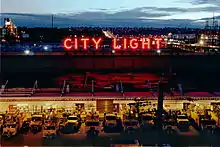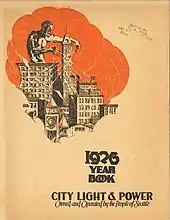Seattle City Light
Seattle City Light is the public utility providing electrical power to Seattle, Washington, in the United States, and parts of its metropolitan area, including all of Shoreline and Lake Forest Park and parts of unincorporated King County, Burien, Normandy Park, SeaTac, Renton, and Tukwila.[1] Seattle City Light is the 10th largest public utility in the United States and the first municipal utility in the US to own and operate a hydroelectric facility. In 2005, it became the first electric utility in the United States to fully offset all its carbon emissions and has remained carbon neutral every year since.
| Agency overview | |
|---|---|
| Formed | 1905: The first municipally owned hydro facility, Cedar Falls, begins generating power for Seattle |
| Type | Electric utility |
| Jurisdiction | City of Seattle and some outlying communities |
| Headquarters | Municipal Tower, 700 Fifth Avenue, Seattle, Washington, United States |
| Employees | 1,872 |
| Agency executive |
|
| Website | http://www.seattle.gov/light |

Seattle City Light is a department of the City of Seattle and is governed by the Housing, Health, Energy & Workers’ Rights committee of the Seattle City Council.
Overview
The approximately 906,595 residents (461,496 metered customers) served by Seattle City Light use about 9,074,062 megawatt-hours annually.[2] Seattle City Light was the first electric utility in the nation to become greenhouse gas neutral (2005)[3] and has the longest-running energy conservation program in the country. The utility owns a large portion of its generation, which is predominately hydro, so is able to offer some of the country's lowest rates to its customers (of utilities in urban areas).[4] Seattle City Light's customer breakdown shows 381,419 residential customers who consumed 2,914,563 megawatt-hours of electricity in 2015 and 41,391 non-residential customers that consumed 6,242,931 megawatt-hours.[5]
History

Public responsibility for electrical energy in Seattle dates to 1890 with creation of the Department of Lighting and Water Works. In 1902, Seattle voters passed a bond issue to develop hydroelectric power on the Cedar River under the administration of the Water Department. Electricity from this development began to serve Seattle in 1905. A City Charter amendment in 1910 created the Lighting Department. Under the leadership of Superintendent James D. Ross, the department developed the Skagit River Hydroelectric Project, which began supplying power in 1924. As superintendent, Ross instituted programs to make Seattle City Light a national model for municipal ownership, such as encouraging the use of electricity for home heating, cooking, and other appliances, and directly selling appliances to customers.[6]:31 He staffed each branch office with an appliance salesman, and arranged for home economists to give lessons on new labor-saving devices.[6]:52 City Light's program of offering free appliance repair, which began in 1910, was ended by a disastrous drought in 1977 that impacted hydropower capacity.[6]:91
Both public and private power were supplied to Seattle until 1951 when the City purchased the private electrical power supply operations, making the Lighting Department the sole supplier. The Boundary Project in northern Washington began operation in 1967 and currently supplies over half of City Light's power generation. Approximately ten percent of City Light's income comes from the sale of surplus energy to customers in the Northwest and Southwest. The current name of the agency was adopted in 1978 when the Department was reorganized.[7]
In 1957, City Light was one of 17 utilities to join the Washington Public Power Supply System (later named Energy Northwest), a municipal corporation, to combine resources and build facilities.[6]:93
In 2014, City Light completed the installation of 41,000 LED street lights along residential streets. Installation of LED streetlights on arterial streets started in 2015 and is expected to be complete by the end of 2018.[8]
The utility's former CEO, Jorge Carrasco, entered a dispute with brand.com over search result "scrubbing" in 2014.[9]
Seattle's electricity supply
The 2016 official fuel mix statistics by the state of Washington for Seattle City Light show approximately 88% hydroelectric, 5% nuclear, 4% wind, 1% coal, 1% natural gas, 1% biogas.[10] City Light's portfolio of energy sources includes electricity purchased through long-term contracts with the Bonneville Power Administration (BPA). The remaining power comes from a mixture of sources.
Owned facilities
The utility owns and operates a total of seven hydro facilities:
- The Skagit River Hydroelectric Project, a series of three hydroelectric dams (Gorge, Diablo, and Ross) on the Skagit River in northern Washington State. The project supplies approximately 25 percent of Seattle's electric power.
- The Boundary Dam on the Pend Oreille River in northeastern Washington State
- Cedar Falls Dam, about 35 miles southeast of Seattle
- South Fork of the Tolt
- Newhalem
Seattle City Light residential customers currently pay about 10–14 cents per kilowatt-hour of electricity. Seattle has the lowest residential and commercial electrical rates among comparably-sized cities in the United States.[11]
Conservation efforts
Seattle's Energy 1990 plan bound City Light to meet load growth through conservation efforts as well as increased power generation. City Light encouraged customers to wrap water heaters, insulate attics, adjust thermostats, and weatherize windows and doors. Over 20 years, conservation efforts reduced use by 6.5 million megawatt-hours and customers' bills by $215 million.[6]:100
City Light implemented programs in the 1990s to mitigate the impact of the Skagit dams on salmon runs. Modifying water regulation to ensure that salmon nests remained under water resulted in a loss equivalent to more than $45 million in potential power over 30 years, yet dramatically increased the number of salmon returning to the Skagit River.[6]:98-99 Conservation efforts expanded in 2000, with increased emphasis on protecting salmon and other species and to develop renewable energy sources.[6]:103
City Light became the first utility in the United States to reach net-zero greenhouse gas emissions in 2005.[6]:118
Labor disputes
Policy changes instituted by the new superintendent, Gordon Vickery, in 1973, angered the employees. Electricians stopped working for 12 days in April 1974 to protest Vickery's management. A second strike by electricians in October, 1975, was at the time the longest public employee walkout in the history of the state. For the 98 days of the strike, supervisors and managers stepped in to keep the system functional, although routine maintenance and new connections stopped. [6]
Art program
Seattle City Light began commissioning decorative designs for its manhole covers in the 1970s after suggestions from Jacquetta Blanchett Freeman, a member of the Seattle Arts Commission. A set of 19 manhole covers with relief maps of Downtown Seattle were designed by city employee Anne Knight and installed beginning in April 1977 to aid with wayfinding.[12][13] Knight's covers use raised symbols to represent local landmarks, including the now-demolished Kingdome, that are labeled with a key on the outer ring other manhole.[14] Other commissioned designs include portraits of city figures, a Tlingit-styled whale, and Nothwestern flowers.[15][16] As of 2012, there are 115 manhole covers in Seattle with decorative designs.[17]
In 2012, the Seattle City Light Conservation Program hired Adam Frank to produce a large scale installation that featured the City of Seattle's hydroelectric power sources. This work of light was a projected living map of Seattle's hydroelectric generation and electricity use.[18]
Notes
- Seattle City Light Rates Area Map, Seattle City Light. Accessed online 2009-10-07.
- , Seattle City Light (2018, based on internal evidence). Accessed online 2016-08-03.
- Stiffler, Lisa; Reporter, Seattle Post-Intelligencer (2005-11-10). "No global warming at City Light". seattlepi.com. Retrieved 2019-01-22.
- http://www.seattle.gov/light/rates/docs/NUand25CitiesRateTable2014.pdf
- http://www.seattle.gov/light/pubs/annualrpt/2015/flipbook/index.html?page=1
- Wilma, David (2010). Power for the people : a history of Seattle City Light. Seattle, Wash: History Ink, in association with University of Washington Press. pp. 87–90. ISBN 978-0-295-98576-3. OCLC 613433169.
- Shannon Lynch and Scott Cline, Guide to the Seattle City Light Department History File 1894-1972, Northwest Digital Archives (NWDA), 2004. Accessed online 2009-10-07.
- http://www.seattle.gov/light/streetlight/led/
- "Seattle utility wants $17,500 refund after failure to scrub negative search results | Ars Technica". Ars Technica.
- Fuel Mix: How Seattle City Light Electricity is Generated (information is for calendar year 2016), Seattle City Light.
- No rate changes at Seattle City Light for 2009, Seattle City Light news release, 2008-09-26. Accessed online 2009-10-07.
- "Art work covering a manhole". The Seattle Times. April 24, 1977. p. C4.
- Chebuhar, Teresa (April 14, 1978). "Getting a round town can be tough". The Seattle Times. p. A1.
- Williams, David B. (2017). Seattle Walks. University of Washington Press. pp. 53–54. ISBN 9780295741284. OCLC 975043400.
- Lyke, M. L. (April 2, 2002). "What lies beneath". Seattle Post-Intelligencer. p. E1.
- "Hatchcover Art in Seattle". Seattle City Light. Retrieved February 3, 2020.
- Wissel, Paula (March 23, 2012). "Why did Seattle turn manhole covers into works of art?". KNKX. Retrieved February 3, 2020.
- "Adam Frank Chosen Seattle City Light Artist-in-residence". Seattle City Light. October 28, 2011. Retrieved February 3, 2020.
